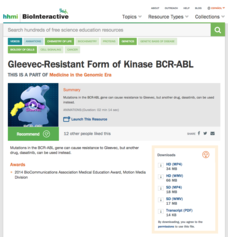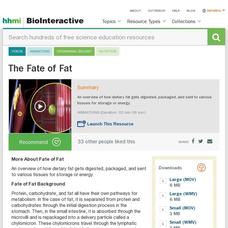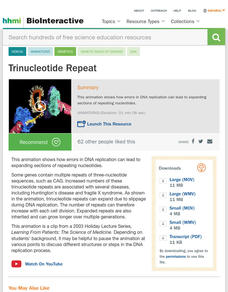Biology Junction
Plant Diversity
Ginkgo trees existed for more than 350 million years, and, at this time, only one species still remains. While plant diversity generally increases over geologic time, some interesting exceptions occur. Young scientists learn about plant...
Curated OER
Errors of Meiosis: Chromosomal Abnormalities
After viewing these concise summaries of the common chromosome abnormalities that cause disorders, students' understanding of genetic errors will be much better. This presentation has clear diagrams to accompany the explanations. The...
Curated OER
Kingdom: Fungi
The general characteristics that affect classification of fungi and other organisms in the domain Eukarya are detailed for the students on 12 attractive slides. Teachers can access individual slides to cover life cycles or diversity, or...
Curated OER
Protists and Fungi
Here is an outstanding presentation on protista. It lists general characteristics, and then moves on to describing three different categories of protists. For each, viewers learn physical features, behaviors, and means of reproduction....
MinuteEarth
Why Are There Dangerous Ingredients In Vaccines?
How does a cocktail of aluminum, formaldehyde, and an infectious disease keep you healthy? Science scholars explore the composition and role of vaccines in a short video that explains how vaccines interact with our immune systems, why...
Howard Hughes Medical Institute
Gleevec Inhibits Cancer-Causing Kinase BCR-ABL
Less than 30 percent of those diagnosed with acute myeloid leukemia live for five years. One researcher shares a breakthrough in treatment for this specific type of cancer. He explains how it spreads and how the medication prevents the...
Biology Junction
Protists and Fungi
It's alive, but what is it? Protists share similarities with plants, animals, and fungi without being classified as any of those three. Learn more about protists and the kingdom fungi with a short presentation. It describes the parts of...
Curated OER
Metabolism & Enzymes
More extensive than just a general overview of digestion and reactions, this slide show gives information about all areas of enzyme function. Topics like the chemistry behind efficiency of enzymes, factors that affect speed of reaction,...
Stated Clearly
What Exactly is a Gene?
What is a gene and how do organisms use them? Find out these answers while learning about how humans have modified genes in plants to best suit their own needs and desires. Before watching the video, you may want to show the video about...
Biology Junction
Nonvascular and Simple Vascular Plants: Mosses to Ferns
Sometimes conservationists use specific plants to prevent erosion or fight invasive species. A 50-slide presentation covers both nonvascular and vascular plants. It discusses the plants, their stages and life cycles, reproduction, uses,...
The Brain Scoop
Dissecting Ants
Scientists study the gut bacteria in ants to better understand their digestive process. Brain Scoop presents the proper way to dissect ants as part of their Insects playlist. The video shows the steps and explains why each is necessary...
Howard Hughes Medical Institute
Gleevec-Resistant Form of Kinase BCR-ABL
Gene mutation occurs at a rate much higher than many realize. Doctors treating cancer and other illnesses must learn to adapt quickly after each mutation. Viewers observe an animation and watch lecture with props to see what happens when...
Howard Hughes Medical Institute
The Fate of Fat
Humans need fat for energy and nutrition, but how much is too much? A short animation shows the pathway of fat as it enters the body, breaks down through digestion, and travels for use or storage. Teaching tips offer multiple ways to...
Howard Hughes Medical Institute
Bacterial Conjugation
Bacteria share the best gifts: genetic code offering drug resistance. As drug resistance becomes more common, scientists share how the process occurs with a brief animation. Viewers see a drug-resistant bacteria use conjugation to pass...
Howard Hughes Medical Institute
Heart Function
The left and right side of the heart must work together flawlessly—that's a lot to coordinate! An animation video shows the operation of each ventricle of the heart and then shows the two parts coming together to complete the loop of...
Howard Hughes Medical Institute
Triplet Code
Genetic code for amino acids always uses three letters. The explanation for why it occurs in triplets makes for a brief statistical video. Examples of single and double letter codes prove insufficient for the number of amino acids.
Curated OER
Fungi
The general characteristics that affect the classification of fungi and other organisms in the domain Eukarya are detailed on 12 attractive slides. Teachers can access individual slides to cover life cycles or diversity, or can use the...
Amoeba Sisters
Bacteria: The Good, The Bad, The Kinda Gross
While the bad bacteria get most of our attention and research into antibiotics, the good bacteria is also important to your health. Explain the different types of bacteria with an illustrative video.
SciShow
The Chemistry of Addiction
Why are addictions so common? A video explains the biological processes associated with addiction and the evolutionary reasons we respond this way. It focuses on the brain and chemical responses. It also explores the links between...
Crash Course
Introduction to Anatomy and Physiology
The average human body loses 40–100 strands of hair in one day. This is the first video in a series of 47 and introduces scholars to anatomy and physiology, the study of the human body, and how it works. The narrator shares the history...
Howard Hughes Medical Institute
Damage to DNA Leads to Mutation
While our bodies have incredible capabilities to repair damage, some mutations accumulate and lead to disease. Follow the life of a DNA mutation using a computer-generated animation. The narrator explains the impact of radiation,...
Howard Hughes Medical Institute
Tri Nucleotide Repeat
Mutations often lead to genetic disorders. The tri-nucleotide repeat leads to an expansion of DNA thanks to errors in the process of DNA replication. Using the informative video, scholars identify genetic disorders related to this error...
Other popular searches
- Plant Cell Biology
- Inquiry Based Cell Biology
- Cell Biology Mitosis
- Cell Structure Powerpoint
- Cell Biology Meiosis
- Cell Structure and Function
- Cell Biology Vocabulary
- Label Cell Parts
- Grade 11 Cell Biology
- Cell Parts Pictures
- Cell Biology Activities
- Human Cell Biology






















